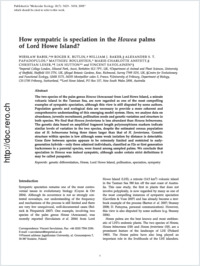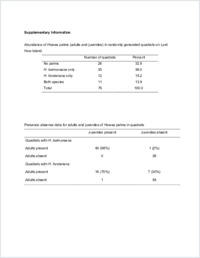How sympatric is speciation in the Howea palms of Lord Howe Island?
- Babik, Wiesław Imperial College London, UK - Jagiellonian University, Kraków, Poland
- Butlin, Roger K. Department of Animal and Plant Sciences, University of Sheffield, UK
- Baker, William J. Royal Botanic Gardens, Kew, Richmond, UK
- Papadopulos, Alexander S. T. Imperial College London, UK
- Boulesteix, Matthieu Imperial College London, UK
- Anstett, Marie-Charlotte Centre for Evolutionary and Functional Ecology, Montpellie, France
- Lexer, Christian Imperial College London, UK - University of Fribourg, Department of Biology, Switzerland
- Hutton, Ian Lord Howe Island, New South Wales, Australia
- Savolainen, Vincent Imperial College London, UK - Royal Botanic Gardens, Kew, Richmond, UK
-
2009
Published in:
- Molecular Ecology. - 2009, vol. 18, no. 7, p. 3629 - 3638
English
The two species of the palm genus Howea (Arecaceae) from Lord Howe Island, a minute volcanic island in the Tasman Sea, are now regarded as one of the most compelling examples of sympatric speciation, although this view is still disputed by some authors. Population genetic and ecological data are necessary to provide a more coherent and comprehensive understanding of this emerging model system. Here, we analyse data on abundance, juvenile recruitment, pollination mode and genetic variation and structure in both species. We find that Howea forsteriana is less abundant than Howea belmoreana. The genetic data based on amplified fragment length polymorphisms markers indicate similar levels of variation in the two species, despite the estimated census population size of H. belmoreana being three times larger than that of H. forsteriana. Genetic structure within species is low although some weak isolation by distance is detectable. Gene flow between species appears to be extremely limited and restricted to early-generation hybrids – only three admixed individuals, classified as F2s or first generation backcrosses to a parental species, were found among sampled palms. We conclude that speciation in Howea was indeed sympatric, although under certain strict definitions it may be called parapatric.
- Faculty
- Faculté des sciences et de médecine
- Department
- Département de Biologie
- Language
-
- English
- Classification
- Biological sciences
- License
-
License undefined
- Identifiers
-
- RERO DOC 12614
- DOI 10.1111/j.1365-294X.2009.04306.x
- Persistent URL
- https://folia.unifr.ch/unifr/documents/301198
Other files
Statistics
Document views: 214
File downloads:
- pdf: 244
- Supplementary material: 130

